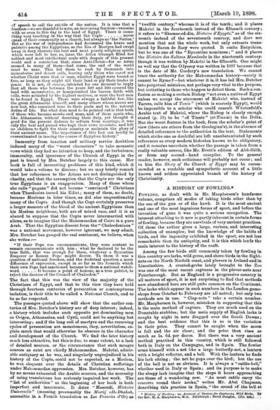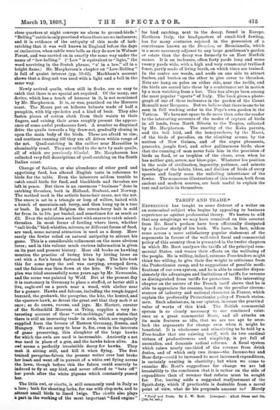A HISTORY OF FOWLING.*
FOWLING, as dealt with in Mr. Macpherson's handsome volume, comprises all modes of taking birds other than by the use of the gun or of the hawk. It is the most ancient and one of the most ingenious forms of sport, and before the invention of guns it was quite a serious occupation. The interest attaching to it now is partly inherent in certain forms of fowling, because they are survivals of very ancient practices. Of these the author gives a large, curious, and interesting collection of examples; but the knowledge of the habits of birds, and the ingenuity exhibited in the sport, are not less remarkable than its antiquity, and it is this which lends the main interest to the history of the craft.
Among the few birds still commonly taken by fowling in this country are larks, wild geese, and shore-birds in the flight- nets on the North Norfolk coast, and plovers in Ireland and in Lincolnshire. A crested-grebe lately brought to the Zoo was one of the most recent captures in the plover-nets near Peterborough. But as England is a progressive country in all matters of sport, it is not surprising to find that methods now abandoned here are still quite common on the Continent. The larks which appear in such numbers in the London game. shops from October to February are all netted ; but only two methods are in use. " Clap-nets " take a certain number. Mr. Macpherson is, however, mistaken in supposing that this is the main method of capture. They are much used on the Dunstable stubbles; but the main supply of English larks is caught by night in nets dragged over the South Downs ; and the best evidence that this is so is the variation in their price. They cannot be caught when the moon is full and the air clear; and the price then rises as much as le. 6d. per dozen. But there was a very ancient method practised in this country, which is still followed both in Italy on the Campagna, and in Spain. The fowler arms himself with a net like a large butterfly-net, a lantern with a bright reflector, and a bell. With the lantern he finds his lark sitting ; the net he pops over the bird; but the use of the bell is not so obvious. It is always a "cattle-bell," whether used in Italy or Spain ; and its purpose is to make the sleepy lark imagine that the steps it hears approaching are those of a wandering cow. "As most cattle carry the cencerro round their necks," writes Mr. Abel Chapman, describing this practice in Spain, "the sound of the bell at
• History of Fowling: an Account of Devices for Capturing Wild Bird.. By the Rev. H. A.. Macpherson, M.A. Edinburgh : David Dough's. [Ma. net.]
close quarters at night conveys no alarm to ground-birds." "Belling" cattle is only practised where there are no inclosures; and it is evidence of the antiquity of this mode of lark. catching that it was well known in England before the days oi enclosures, when cattle wore bells as they do now in Wolmer Forest, and was carried on in exactly the same way under the name of "low-belling." ("Low" is equivalent to" light," the word surviving in the Scotch phrase, "a' in a low," all in a bright flame.) Mr. Maepherson's chapter on "Low-Belling" is full of quaint interest (pp. 59.62). Markham's account shows that a dragnet was used with a light and a bell in the same way.
Newly arrived quails, when still in flocks, are 80 easy to catch that there is no special art required. Of the many, one device, which has a touch of humour in it, is not mentioned by Mr. Macpherson. It is, or was, practised on the Morocco coast. The Moors put on hideous helmets made of half a pumpkin, with big eye-holes and a kind of beak. They also fasten pieces of cotton cloth from their waists to their fingers, and raising their arms roughly present the appear- ance of some awful predaceous fowl. A number so disguised drive the quails towards a big draw-net, gradually closing in upon the main body of the birds. These are afraid to rise, and continue running till they are all driven within range of the net. Quail-catching in the caillers near Marseilles is abominably cruel. They are called to the nets by male quails, all of which are previously blinded. Mr. Macpherson has collected very full descriptions of quail-catching on the South Italian coast.
Change of fashion, or else abundance of other good and appetising food, has altered English taste in reference to birds for the table. Even the labourers seldom trouble to catch small birds for food, and blackbirds and thrushes are left in peace. But there is an enormous " business " done in catching thrushes, both in Holland, Brabant, and Norway. The method used is the artistic horse-hair snare, not the net. The snare is set in a triangle or loop of willow, baited with a bunch of mountain-ash berry, and then hung up in a tree or bush. In parts of Belgium the rowan-berry bait is sold for from 5s. to 10s. per bushel, and sometimes for as much as £2. Even the mistletoes are beset with snares to catch missel- thrushes. In most forms of fowling where lures, whether "call-birds," bird-whistles, mirrors, or different forms of food, are used, some natural attraction is used as a decoy. More rarely the fowler relied on natural antipathy to attract his game. This is a considerable refinement on the more obvious lures ; and in this volume much curious information is given on its past and present history. Most old books on hawking mention the practice of luring kites by letting loose an owl with a fox's brush fastened to his legs. The kite took this for some prey the owl was carrying, swooped down, and the falcon was then flown at the kite. We believe this plan was tried successfully some years ago by Mr. Newcombe, and the scene was painted by Wolf. But at the present day it is customary in Germany to place a stuffed, or better still a live, eagle-owl on a perch near a wood, with shelter near for a gunner. Hawks and falcons, including the rough-legged buzzard, the goshawk, the peregrine, the kite, the kestrel, and the sparrow-hawk, so detest the great owl that they mob it at once ; so do crows, ravens, and jays. Mr. Hartert, curator of the Rothschild Museum at Tring, supplies a very in- teresting account of these " owl-mobbings," and states that there is still an increasing trade in owls, which are regularly supplied from the forests of Eastern Germany, Russia, and Hungary. We are sorry to hear it, for, even in the interests of game preserving, this slaughter of the large hawks for which the owls are used is inexcusable. Anciently a net was used in place of a gun, and the hawks taken alive. An owl seems a perfectly irresistible decoy for hawks. They mob it sitting still, and kill it when flying. The first trained peregrine-falcon the present writer ever lost broke her leash and went off in pursuit of a white owl flying across the lawn, though before this the falcon could scarcely be induced to fly at any bird, and never offered to "bate off" her perch after the white pigeons which constantly passed her.
The little owl, or ciretta, is still commonly used in Italy as a lure ; both for shooting larks, for use with clap-nets, and to attract small birds to limed twigs. The civetta also plays 'a part in the working of the most important "fixed engine" for bird catching, next to the decoy, found in Europe. Northern Italy, the headquarters of small-bird fowling, has for many centuries rejoiced in the possession of a contrivance known as the Brescian, or Brescianella, which is a more necessary adjunct to any large gentleman's garden or estate than the decoy was formerly to an East Norfolk manor. It is an inclosure, often forty yards long and some twenty yards wide, with a high and very ornamental trellised fence, partly made of living beech, on which vines are trained. In the centre are weeds, and seeds on one side to attract finches, and bushes on the other to give cover to thrushes. Nets are hung on poles on either side, near the trellis, and the birds are scared into these by a contrivance set in motion by a man watching from a hut. This has always been among the most popular " sports " of Italy. The book gives a photo- graph of one of these inclosures in the garden of the Count Roncalli near Bergamo. But we believe that there is one to be seen in full working order in the Pope's own garden in the Vatican. We have not space to do more than refer the reader to the interesting accounts of the modes of capture of birds in all lands, from North Siberia to the Tropics, collected by Mr. Macpherson. The snaring of the Kaka parrots, and the bell bird, and the honeysuckers, by the Maori, of the birds of paradise, on the climbing arums, by the natives of New Guinea, and of the argue pheasants, peacocks, jungle fowl, and other gallinaceous birds, show that the cunning of man never fails him in the provision of birds as food, or as trophies of the chase, even when he has neither gun, arrow, nor blow-pipe. Whatever his position in the scale of civilisation, ingenuity, patience, and minute knowledge of the habits, likes, and dislikes of birds of every species and family seem the unfailing inheritance of the fowler. The numerous illustrations of this volume, both from ancient and modern sources, are both useful to explain the text and artistic in themselves.







































 Previous page
Previous page